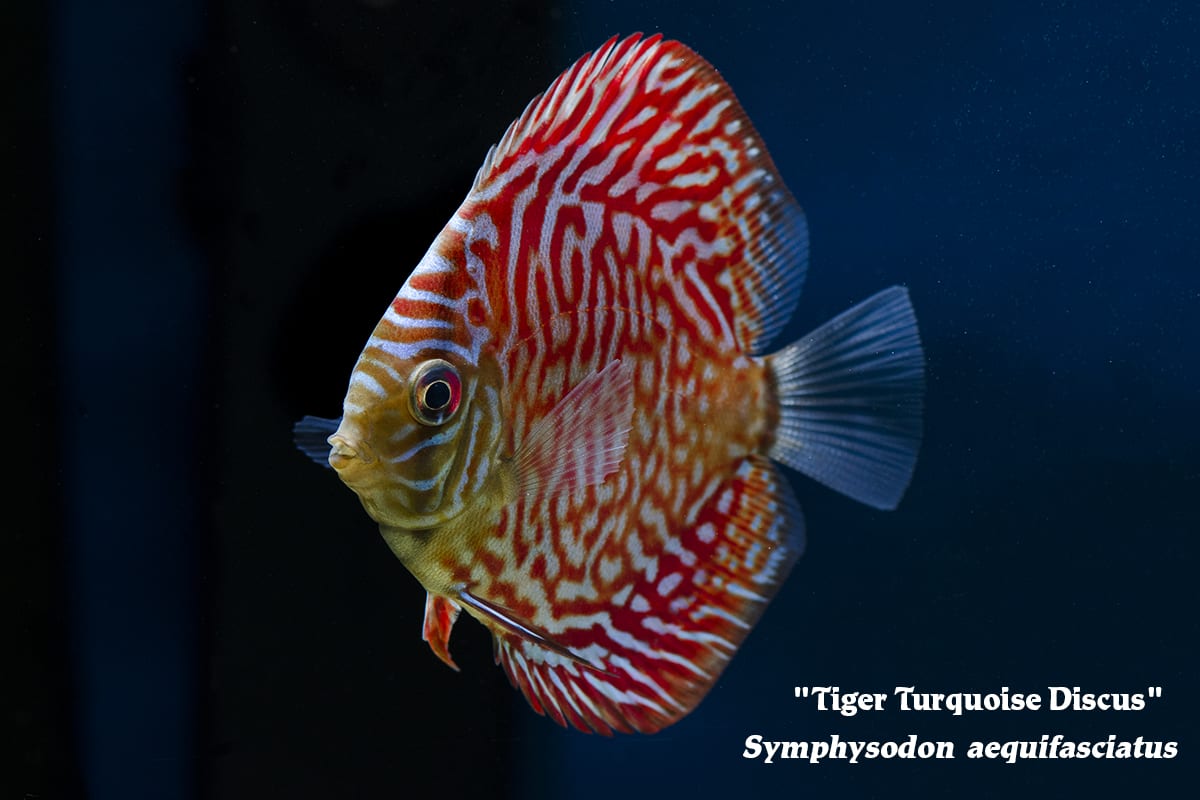Eye of the Tiger
Eye of the Tiger
The largest cats on earth, the tiger is one of the most recognizable and popular creatures for their beautiful dark striping over golden bodies. Present in nearly every creative outlet from design to literature (shout out to William Blake’s “The Tyger” for poetry month), it’s no surprise ichthyologists and aquarists have drawn inspiration from these majestic felines when naming newly discovered species and breeding new color morphs. A few of our favorite tiger-like aquarium companions include Datnioides polota, Batasio fluviatilis, and Symphysodon aequifasciatus.
Scientific NameDatnioides polota
Common NameIndian Tiger Fish
Temperature / pH72 to 82°F / 7.5 to 9.0 pH
Native LocationSoutheast Asia
Preferred DietCarnivorous
“Roaring” through brackish habitats, and widely distributed throughout Southeastern Asia is D. polota. Known as “Indian Tiger Fish”, these beauties reach about 11.5 inches in length, and exhibit-you guessed it- tiger-like stripes along mottled gold bodies, and pointed, upturned faces. Inhabiting brackish waters like estuaries, mangroves, lagoons, and canals, they do best in tanks furnished with driftwood branches or mangrove roots, floating or overhanging vegetation, and about 10-20% marine salt. Additionally, these datnioides produce a significant amount of waste requiring filtration units. Since they grow so large, they should be kept in large tanks above 50 gallons, especially if kept in groups. They tend to be territorial and aggressive with conspecifics, and are best kept in groups of 5 or more to allow a natural dominance hierarchy to form provided enough tank space, or singly in smaller tanks. Generally, they can be kept alongside similarly-sized species that are not territorial or competitive. Exhibiting highly protrusible mouths, Indian tiger fish are effective predators that feed on small fish and crustaceans in nature, so they should not be kept in tanks with small species. In aquaria, they can be fed live and frozen worms, chopped prawns, mussels, and strips of fish meat. They cannot properly metabolize lipids present in mammalian or avian meats, which should never be introduced to their diets. Tank waters are best maintained with temperatures between 72 and 82°F, pH of 7.5 to 9.0, and hardness of 268 to 536 ppm.
Scientific NameBatasio fluvatilis
Common NameBengal Tiger Catfish
Temperature / pH62 to 72°F / 6.0 to 7.0 pH
Native LocationSoutheast Asia
Preferred DietSmall invertebrates
Whiskers and all, this tiger doppelganger, B. fluviatilis hails from southern Thailand and peninsular Malaysia. Reaching a max size of 3 inches, these “Bengal Tiger Catfish” have rounded snouts covered in whiskers, and long golden bodies striped with black bands. All catfish species in this genus only inhabit headwaters of small streams with shallow, fast-flowing, and highly oxygenated stretches. In aquaria, we recommend tanks be set up to mimic flowing rivers with powerheads or canister filters, sandy substrate, variable-sized water-worn rocks, driftwood branches, roots, and tough aquatic plants. Make sure they have plenty of dark hideaways for when the world becomes too overwhelming to keep them stress-free. Intolerant to the buildup of waste, waters must be kept in pristine condition, and weekly water changes of 30 to 50% are recommended. Docile and not generally competitive, these catfish should not be considered community fish, and should only be kept alongside small schooling cyprinids, characids, live-bearers, or loaches. Feeding primarily on small invertebrates and zooplankton in nature, they are best kept on diets consisting of small live and frozen bites like bloodworm, artemia, and mosquito larvae. Tank waters should be kept with temperatures of 62 to 72°F, pH between 6.0 and 7.0, and hardness of 18 to 215 ppm.
Scientific NameSymphysodon aequifasciatus
Common NameTiger Turquoise Discus
Temperature / pH80 to 84°F / 5.0 to 7.0 pH
Native LocationAmazon basin
Preferred DietSmall invertebrates
Similarities extending beyond appearance, S. aequifasciatus is exotic, and notoriously difficult to tame. The “Tiger Turquoise Discus” is one of the most sought after morphs of discus fish for their beautiful red tiger-like striping and markings over their bright turquoise bodies. Originating in the Amazon River, discus are for the most dedicated aquarists. Reaching up to 9 inches, these fish are essentially round disks, and many color morphs with different patterning are bred and available in the aquarium trade. Their natural habitats are slow-moving tributaries and forest pools of main river channels, where they school and live in shady areas among roots and rocks. In aquaria, they are best kept in tanks of more than 50 gallons for a single pair, and larger for larger groups. These shy fish do best in planted setups and areas of cover, though they also require ample swimming space. Not particularly aggressive by nature, they can be kept alongside small, nonaggressive, and slow species like neon tetras. Though they are schooling by nature, they should only be kept in conspecific groups of 4-6, and individuals should similar in size or at the same stage of development. Sensitive to water quality their tanks should be equipped with good filtration systems, and frequent water changes are required. Feeding mainly on zooplankton and small invertebrates in nature, they do best in aquaria with diets consisting of quality pellets designed for discus, and regular live and frozen offerings. It is of utmost importance that tank water parameters remain consistent, with temperatures of 80 to 84°F, pH of 5.0 to 7.0, and hardness between 17 and 69 ppm.
Looking to earn your stripes as an aquarist? Look no further than these tiger-striped fellows. The Wet Spot has a number of species with feline inspired pattern morphs. If these three didn’t quite make the mark, give us a call, and we’ll help you find the right additions for your cohort.


